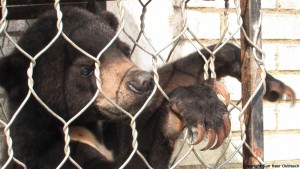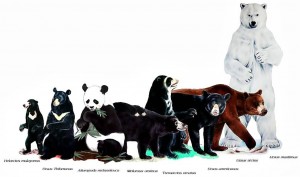Scientific name: Helarctos malayanus
Status: Vulnerable
Length: 120 – 150cm
Weight: 20 – 70kg
Habitat: Tropical lowland areas, SE Asia
Diet: Omnivorous
Average number of cubs: one
Life-expectancy: 30 years
Sun bears are the smallest, most arboreal and least studied bears in the world. Their estimated population size is unknown. Their name comes from the pale golden horseshoe patch on their chests, which is said to resemble the setting or rising sun. Like a thumbprint, no two markings are the same.
They have a very long tongue of 20 to 25cm. This helps them extract honey from bee hives, earning them the alternative name ‘honey bear’ or ‘beruang madu’ in Malay and Indonesian.
Sun bears live in tropical lowland forests. They are found essentially on the Island of Borneo and Sumatra (Indonesia) but also in Malaysia, Thailand, Laos, Cambodia, Vietnam, Burma, Bangladesh, North-Eastern India and South China. They are mainly diurnal and do not hibernate but build nests in trees to sleep in. They are omnivores and primarily eat invertebrates, fruit and honey.
Threats
 The total sun bear population has declined by at least 30% in the last 30 years contributing to sun bears being classified as ‘vulnerable’ in 2007 meaning they are at high risk of extinction in the wild. Sun bears face three main threats:
The total sun bear population has declined by at least 30% in the last 30 years contributing to sun bears being classified as ‘vulnerable’ in 2007 meaning they are at high risk of extinction in the wild. Sun bears face three main threats:
- Habitat loss – Like many species, deforestation and degradation of habitat has dramatically decreased their numbers. The main causes in Borneo are plantation development, unsustainable or illegal logging and human-caused fires. In Sumatra and Borneo, large-scale conversion of forest to oil palm or other cash crops is proceeding at a rate of thousands of km² per year.
- Commercial hunting – Sun bears are primarily hunted for their gall bladders (for use in Chinese folk medicine) and bear paws (as an expensive delicacy). In China and Vietnam, bile is milked from bears while they are still alive. Bears are routinely restocked as they do not live long. Killing sun bears is illegal in all of their native counties but is largely uncontrolled.
- Pet trade – Sun bears are the smallest bear in the world. As such, their cubs appear cuddly and harmless, creating a high demand for them as pets. The mothers are killed and the orphaned cubs are removed from the wild and commonly kept in small cages with inadequate care.

